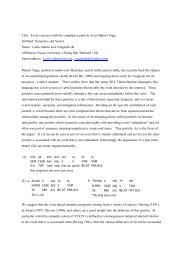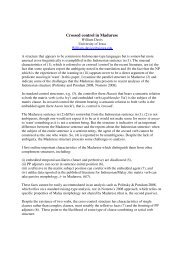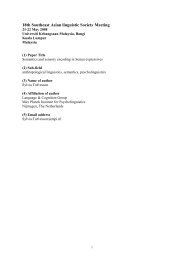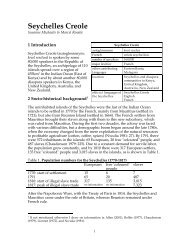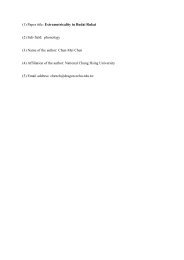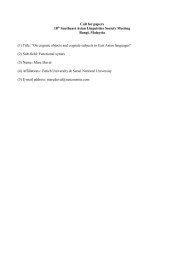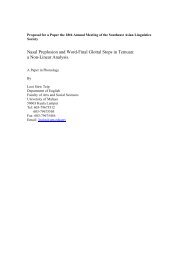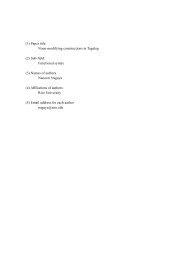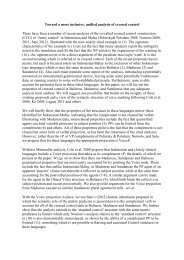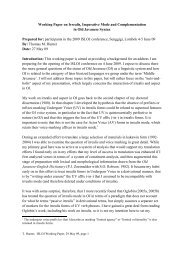The Information Structure of Nominal Phrases and DP-internal ...
The Information Structure of Nominal Phrases and DP-internal ...
The Information Structure of Nominal Phrases and DP-internal ...
Create successful ePaper yourself
Turn your PDF publications into a flip-book with our unique Google optimized e-Paper software.
1) Paper title: <strong>The</strong> <strong>Information</strong> <strong>Structure</strong> <strong>of</strong> <strong>Nominal</strong> <strong>Phrases</strong> <strong>and</strong> <strong>DP</strong>-<strong>internal</strong> Phrasal<br />
Movement in Buginese<br />
(2) Sub-field: formal syntax<br />
(3) Name <strong>of</strong> author: Yi-An Lin<br />
(4) Affiliation <strong>of</strong> author: University <strong>of</strong> Cambridge<br />
(5) Email address for each author: yal23@cam.ac.uk
<strong>The</strong> <strong>Information</strong> <strong>Structure</strong> <strong>of</strong> <strong>Nominal</strong> <strong>Phrases</strong> <strong>and</strong> <strong>DP</strong>-<strong>internal</strong> Phrasal Movement in<br />
Buginese<br />
Following Aboh’s Split DeterminerPhrase (<strong>DP</strong>) hypothesis, this paper argues that the<br />
information structure is encoded in the syntactic structure <strong>of</strong> nominal phrase based on the<br />
linguistic data <strong>of</strong> Buginese, an Austronesian language spoken in Indonesia. As indicated by<br />
Nishiyama (1998), Buginese nominals allow a remarkable free word order:<br />
(1) a. iaro lima buku-e b. lima iaro buku-e c. lima buku-e iaro<br />
those five book-the five those book-the five book-the those<br />
d. iaro buku lima-e e. buku iaro lima-e f. buku lima-e iaro<br />
those book five-the book those five-the book five-the those<br />
According to Nishiyama’s iterated <strong>DP</strong> analysis, where demonstratives project a <strong>DP</strong> <strong>and</strong><br />
c-select another <strong>DP</strong> headed by the definite marker –e, (1a) is the underlying structure<br />
generated by the operation Merge only, whereas (1b-f) are derived by <strong>DP</strong>-<strong>internal</strong> phrasal<br />
movement. However, cross-linguistically speaking, the postulation that demonstratives<br />
project an upper <strong>DP</strong> is quite idiosyncratic. Moreover, as admitted by Nishiyama himself, the<br />
discussion <strong>of</strong> what sort <strong>of</strong> feature triggers the proposed movement is absent in his analysis.<br />
<strong>The</strong>refore, the current paper intends to fill in this gap in terms <strong>of</strong> Chomsky’s (2001, 2005)<br />
Probe-Goal approach <strong>of</strong> Minimalism. Given Aboh’s (2004) Split <strong>DP</strong> hypothesis, which argues<br />
that the left periphery <strong>of</strong> nominal phrase encode the information structure in the same way as<br />
the left periphery <strong>of</strong> clause, I re-interpret Nishiyama’s analysis by saying that all the examples<br />
in (1) are derived by <strong>DP</strong>-<strong>internal</strong> topicalization <strong>and</strong>/or focalization proceeded by a phrasal<br />
movement, namely the movement <strong>of</strong> Num(ber)P to the Spec(ifier) <strong>of</strong> lower <strong>DP</strong> in<br />
Nishiyama’s proposal. <strong>The</strong> <strong>internal</strong> structure I propose for Buginese nominal is schematized<br />
as:<br />
(2) DtopicP>DfocusP>DtopicP> DdefiniteP>NumP>SpecificityP>nP>NP.<br />
Following Li’s (1999) study on NumP <strong>and</strong> Sio’s (2006) study on S(pecificity)P, I assume<br />
numerals are accommodated in SpecNumP <strong>and</strong> demonstratives are accommodated in SpecSP<br />
<strong>and</strong> moved to SpecDdefiniteP. Furthermore, I assume the optional movement as in the<br />
<strong>DP</strong>-<strong>internal</strong> topicalization or focalization is triggered by the edge feature whereas the<br />
obligatory phrasal movement such as the movement <strong>of</strong> NumP to SpecDdefiniteP is triggered by<br />
the [EPP] feature. <strong>The</strong> interaction <strong>of</strong> these two types <strong>of</strong> movements then leads to the free<br />
word order in Buginese nominal phrases shown in (1). <strong>The</strong> derivation process as mentioned is<br />
that the obligatory movement <strong>of</strong> NumP to SpecDdefiniteP takes place before the <strong>DP</strong>-<strong>internal</strong><br />
topicalization or focalization which targets SpecDtopicP or SpecDfocusP respectively.
References<br />
Aboh, Enoch. 2004. Topic <strong>and</strong> focus within D. Linguistics in the Netherl<strong>and</strong>s 21: 1-12.<br />
Chomsky, Noam. 2001. Derivation by phase. In M. Kenstowicz (ed.) Ken Hale: A Life in<br />
Language, 1-52. Cambridge: MIT Press.<br />
Chomsky, Noam. 2005. On phases. Manuscript: MIT.<br />
Li, Audrey Y.-H. (1999). Plurality in Classifier Language. Journal <strong>of</strong> East Asian Language 8:<br />
75-99.<br />
Nishiyama, Kunio. (1998). Free Order in Buginese Noun <strong>Phrases</strong> <strong>and</strong> <strong>DP</strong>-Internal<br />
XP-Movement. In N. Tamanji <strong>and</strong> K. Kusumoto (eds.) NELS 28, 121-135.<br />
Sio, Joanna U.-S. (2006). Modification <strong>and</strong> Reference in the Chinese <strong>Nominal</strong>. PhD<br />
dissertation: Leiden University.




